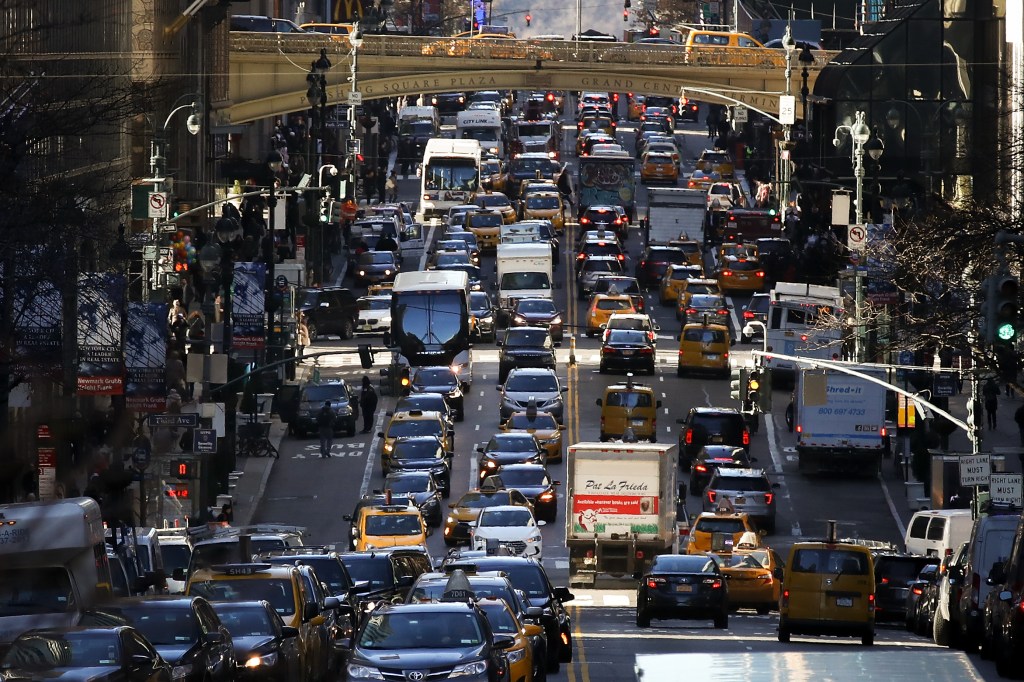With all the debate about congestion pricing very little has been said about “congestion.” INRIX just labeled NYC the most congested city on the planet. Traffic speeds in Midtown at 4.5 mph are the lowest ever. The Partnership for New York City says it costs all of us $20 billion annually. But these are just numbers; what do they mean in our daily life? Let me explain in easy-to-understand terms what this means by using yellow taxis as an example.
More than 55 years ago, way before I became Gridlock Sam traffic columnist for the Daily News or started working for the city’s Traffic Department (subsumed within the DOT in 1978), I was a cab driver. I mostly worked the less profitable (due to slower speeds) day shift after a few nighttime escapades involving drunk passengers and my need to clean the cab. Day riders were far more sober.
I worked out of Tone Taxi on 18th Ave. in Bensonhurst, Brooklyn. Drivers got 49% of the meter and kept all the tips. Everything was cash in those days. I typically earned $35/day, the equivalent of $316/day today. Since cabbies reported just a fraction of their tips my earnings were closer to $400/day in 2024 dollars or six figures annually.
On my day shift I was able to pick up 25 to 30 fares or nearly three an hour. More than half my fares were in Midtown where speeds were about 8 mph (as I found out a few years later while working for the Traffic Department). With an average distance of about 2.5 miles, I was able to travel with a fare in less than 20 minutes.
Today Midtown speeds are about 4.5 mph. So, to travel 2.5 miles now takes 33 minutes. And it’s not just the cabbie who suffers. The extra 13 minutes of delay in a cab adds as much as $9 to the fare on top of about $16, had it been congestion-free. Just two fares would take more than an hour for a cabbie today even without any cruising.
Ask any cabbie how many trips they make in a shift, and they will usually tell you fewer than 20. A service or delivery truck suffers the same fate- fewer trips per shift. Congestion is bad for business.
How do I know so much about speeds and that we are slowest ever? In 1971 I replaced the retired Jacob Greissman as director of research for the city traffic agency. Greissman developed a device that would record speeds on a graph, kind of like an old EKG printout, so one could record speeds in cars. He used it to record Midtown speeds by avenue and street. He had just retired, and I inherited his files including Midtown speed data that went back to 1915 (7 mph). Today speeds are measured by GPS in vehicles and using smart phone data.
John Lindsay was mayor when I started, and he had an ambitious plan to ban cars from Midtown in a project dubbed “The Red Zone.” My job was to measure traffic speeds before and after implementation (“after” never happened; in a moment reminiscent of Gov. Hochul’s “pause” on congestion pricing 25 days before the start, Lindsay aborted the Red Zone just weeks before implementation).
We only had one Greiss-o-graph so I sent out about 10 teams of traffic inspectors with stopwatches to record block by block times crosstown and avenue times at major cross streets. Speed = Distance/Time so I was able to convert the data into speeds. I recently found my files from 1971 and the alarming, paralyzing speeds that led Lindsay to propose banning cars was 8.4 mph — an unheard of speed in the past decade since the introduction of app-based car services like Uber and Lyft as well as the surge in app-based truck deliveries.
The MTA’s congestion pricing plan would have addressed the impacts by car services by imposing a $2.50 charge per trip on car services and $1.25 charge for taxis. Trucks would have also faced peak charges of $24 or $36. A drop of about 100,000 cars entering the zone was predicted in the MTA’s 4,000-page Environmental Assessment.
When the governor says she’s worried about the working-class New Yorkers who would suffer under congestion pricing I think about the taxi and truck drivers stuck in traffic, the stores that pay more for goods and services, the tens of thousands of middle-class jobs that would be unleashed by $15 billion in capital spending and millions of transit riders who would get improved service. And governor, I also think of the diner owners would benefit with lowered delivery costs and more customers.
Schwartz is a former NYC traffic commissioner.
